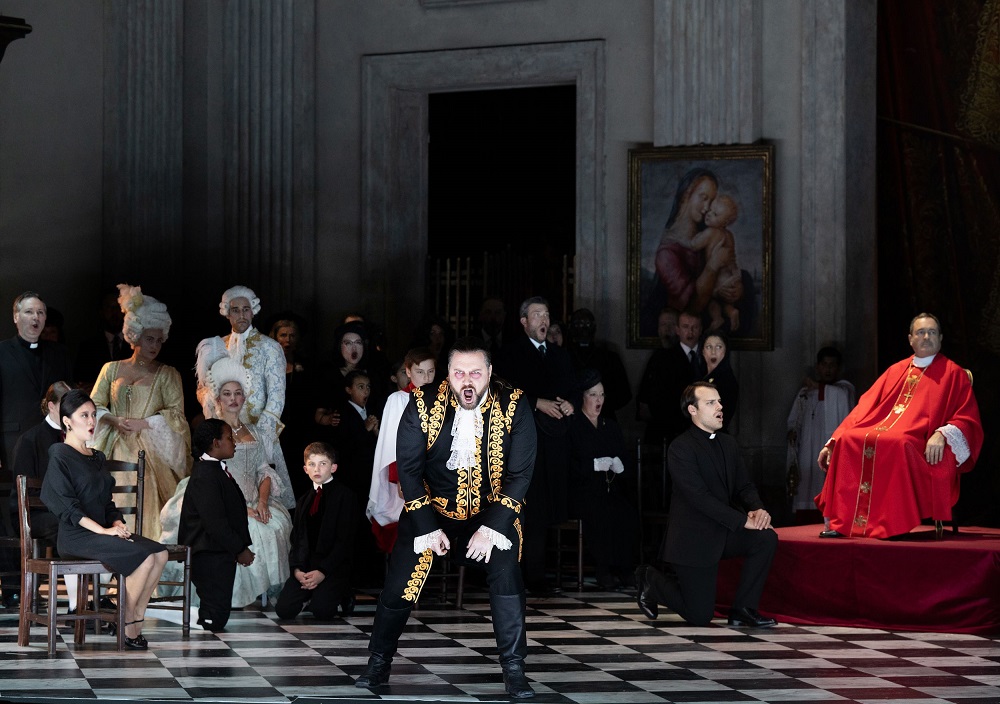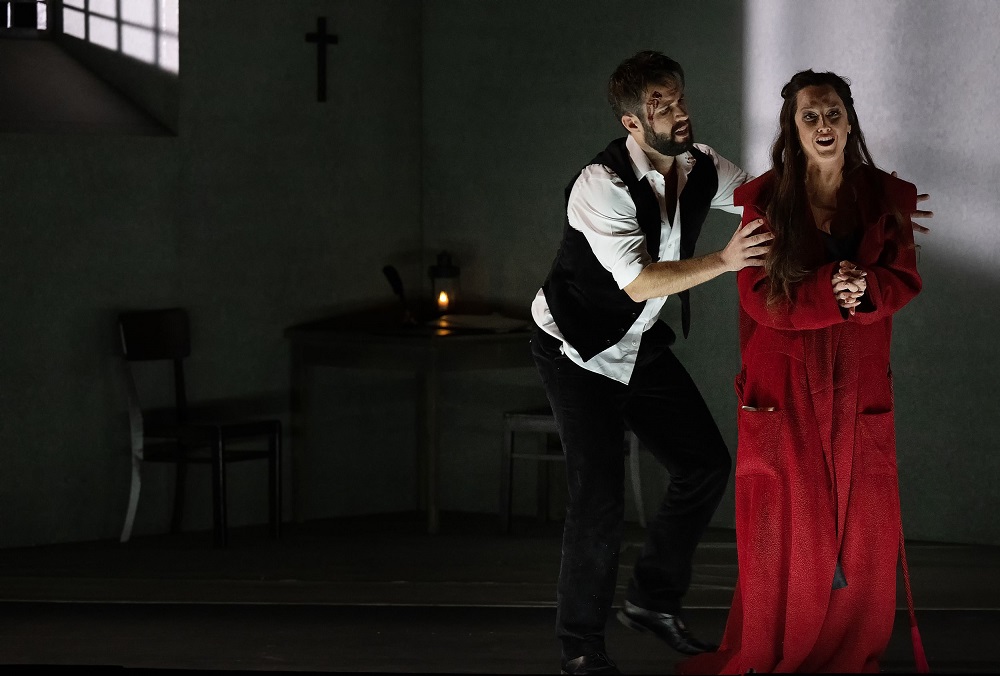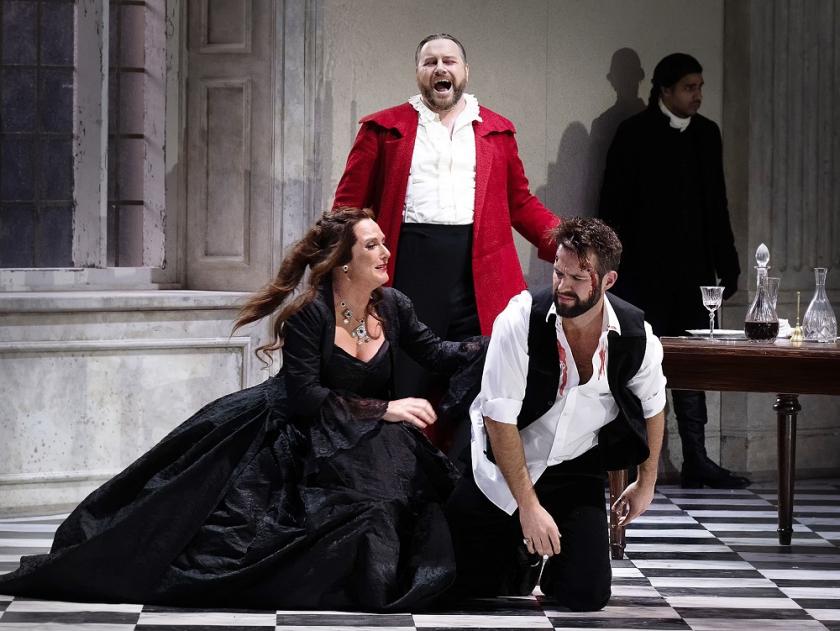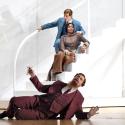Rome, 14/15 June 1800: the specifics of the original Sardou melodrama are preserved in Puccini’s thriller mixing love, lust, religion and tyranny. Many productions move forward in time, and sometimes change the place, with ease: after all, feudalist power-abusers remain with us. Director Christof Loy decides that police chief Scarpia and his allies should be of the era following the French revolution, while artist Cavaradossi is a “timeless” freedom fighter.
The results, first seen at Finnish National Opera, weaken the immediacy of this brilliant music-drama, while keeping much of the action as we traditionally see it (as Loy puts it in his programme note, "no wonder people say Puccini already directed this opera while composing it").
For the most part, it doesn't hit as effectively as the ENO predecessor, directed by former Tosca Catherine Malfitano. The few production "twists", beyond the costumes, merely confuse us: why is Scarpia having a fit during the Te Deum, why those 18th century figures in white, presumably participants in the evening's cantata, in amongst the 1940s church worshippers (pictured below)? Why bother having the little shepherd in the pre-dawn mood music of Act 3 dressed up as a mini-Tosca to haunt Cavaradossi in prison (though the resolutely non-operatic, non-diva song is well done by young Matilda McDonald)? The final sequence, with cardboard-cut out, bewigged soldiers frozen on stage as Tosca tells her love to fall as she does on the stage, presuming that Scarpia has ordered a fake execution, is botched, even if we do get a belated diva-hurl over the battlements.  What's left more or less as in the original scenario, namely most of Act 2, really works. This is in no small measure due to a pair of lovers who really have the money notes – dramatic, exciting ones as Scarpia's screw begins to turn. Both Sinéad Campbell-Wallace and Adam Smith could afford to fine-tune, to give us a bit more nuance, but they're convincing performers. He's tall, handsome and vocally solid (and doesn't he know it, which is fine when the top A sharp/B flat of the victory-cry is that good). She is a piece of work from the start, but not without charm in the Act One duet; it was good to hear ripples of laughter in the audience, including quite a few under-21s who'd taken advantage of ENO's free tickets, at the absurdity of her jealousy). She remains utterly convincing in her disgust and desperation as Scarpia plans her rape; although Loy has the idea of a theatrical red curtain to underline her diva-ness, she keeps it realistic (the two pictured below in Act Three).
What's left more or less as in the original scenario, namely most of Act 2, really works. This is in no small measure due to a pair of lovers who really have the money notes – dramatic, exciting ones as Scarpia's screw begins to turn. Both Sinéad Campbell-Wallace and Adam Smith could afford to fine-tune, to give us a bit more nuance, but they're convincing performers. He's tall, handsome and vocally solid (and doesn't he know it, which is fine when the top A sharp/B flat of the victory-cry is that good). She is a piece of work from the start, but not without charm in the Act One duet; it was good to hear ripples of laughter in the audience, including quite a few under-21s who'd taken advantage of ENO's free tickets, at the absurdity of her jealousy). She remains utterly convincing in her disgust and desperation as Scarpia plans her rape; although Loy has the idea of a theatrical red curtain to underline her diva-ness, she keeps it realistic (the two pictured below in Act Three).
One of the wonders of the operatic world is how superbly a singer can deliver who's called in at the last minute to be the "voice" of an under-the-weather performer going through the motions on stage. American Noel Bouley mimed Scarpia – and it seems Loy doesn't in any case want to give this unbridled police chief any controlled wielding of power – while Roland Wood, experienced in the role, sang it thrillingly from the side of the stage. Disbelief was duly suspended,  Minor roles don't get much characterisation – you feel two major voices are wasted on Scarpia's henchman Spoletta (Jon Findon) and the Sacristan (Lucia Lucas, asked to play it straight, which at least absolves us of the usual overdone business). The acting space, handsomely designed by Christian Schmidt so that the Act One church could convert well into the Act Two palazzo room, and dramatically lit by Olaf Winter, serves the performers very well. Leo Hussain, not so much – you felt they often wanted to move the phrases on more than he did, a battle of wills ensuing of the kind you sometimes hear on Karajan's Puccini recordings. But he certainly made the ENO Orchestra glow. For all the drawbacks, this is a fine enough Tosca for a first-time viewer to feel the power. Last but not least, I really admired the Tosca-inspired poem delivered by spoken word artist Kieron Rennie before the opera began – this creative residency is surely a good thing, and the performance did what it promised – connected with the drama.
Minor roles don't get much characterisation – you feel two major voices are wasted on Scarpia's henchman Spoletta (Jon Findon) and the Sacristan (Lucia Lucas, asked to play it straight, which at least absolves us of the usual overdone business). The acting space, handsomely designed by Christian Schmidt so that the Act One church could convert well into the Act Two palazzo room, and dramatically lit by Olaf Winter, serves the performers very well. Leo Hussain, not so much – you felt they often wanted to move the phrases on more than he did, a battle of wills ensuing of the kind you sometimes hear on Karajan's Puccini recordings. But he certainly made the ENO Orchestra glow. For all the drawbacks, this is a fine enough Tosca for a first-time viewer to feel the power. Last but not least, I really admired the Tosca-inspired poem delivered by spoken word artist Kieron Rennie before the opera began – this creative residency is surely a good thing, and the performance did what it promised – connected with the drama.















Add comment